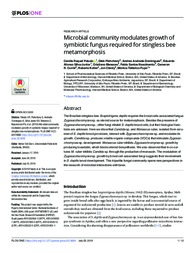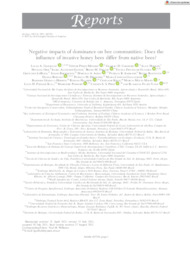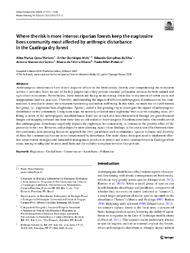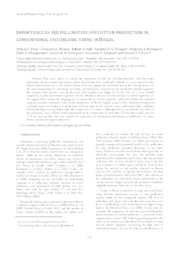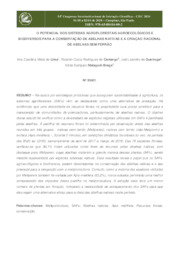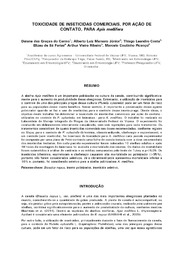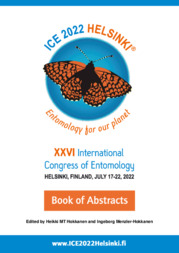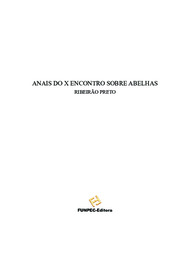Search Publications
Filter by:
| Author(s): PALUDO, C. R.; PISHCHANY, G.; DOMINGUEZ, A.-A.; SILVA JÚNIOR, E. A.; MENEZES, C.; NASCIMENTO, F. S.; CURRIE, C. R.; KOLTER, R.; CLARDY, J.; PUPO, M. T. Abstract: The Brazilian stingless bee Scaptotrigona depilis requires the brood cells-associated fungus Zygosaccharomyces sp. as steroid source for metamorphosis. Besides the presence of Zygosaccharomy... ... |
| Author(s): GARIBALDI, L. A; PÉREZ-MÉNDEZ, N.; CORDEIRO, G. D.; HUGHES, A.; ORR, M.; SANTOS, I. A. dos; FREITAS, B. M.; OLIVEIRA, F. F. de; LEBUHN, G.; BARTOMEUS, I.; AIZEN, M. A.; ANDRADE, P. B.; BLOCHTEIN, B.; BOSCOLO, D.; DRUMOND, P. M.; GAGLIANONE, M. C.; HERREN, B. G.; HALINSKI, R.; KRUG, C.; MAUES, M. M.; KIILL, L. H. P.; PINHEIRO, M.; PIRES, C. S. S.; VIANA, B. F. Invasive species can reach high abundances and dominate native environments. One of the most impressive examples of ecological invasions is the spread of the African sub-species of the honey bee throu... ... |
| Author(s): MARIANO, A. M. C.; MELO, A. D.; SILVA, E. G. da; SANTOS, A. M. dos; RIBEIRO, M. de F.; PINHEIRO, P. M. Anthropogenic disturbances have drastic negative effects on the biodiversity, thereby also compromising the ecosystem service it provides. Bees are one of the key players since they provide essential... ... |
| Author(s): PIRES, V. C. P.; SILVEIRA, F. A.; SUJII, E. R.; TOREZANI, K. R. S.; RODRIGUES, W. A.; ALBUQUERQUE, F. A. de; RODRIGUES, S. M. M.; SALOMAO, A. N.; PIRES, C. S. S.
|
| Author(s): LIMA, A. C. V. de; CAMARGO, R. C. R. de; QUEIROGA, J. L. de; MALAGODI-BRAGA, K. S. Resumo: Na busca por estratégias produtivas que assegurem sustentabilidade à agricultura, os sistemas agroflorestais (SAFs) vêm se destacando como uma alterna de produção. Há evidências que uma divers... ... |
| Author(s): CARMO, D. das G. do; MARSARO JÚNIOR, A. L.; COSTA, T. L.; FARIAS, E. de SÁ; RIBEIRO, A. V.; PICANÇO, M. C.
|
| Author(s): DORNELES, A. L.; VICARI, C. C.; CARVALHO, F. G. de; SATTLER, A.; BLOCHTEIN, B.; MARSARO JÚNIOR, A. L.
|
| Author(s): SANTOS, I. A. dos; SILVA, C. I.; SCHLINDWEIN, C.; KRUG, C.; CORDEIRO, G. D.; OLIVEIRA, R.; MATEUS, S.; DÖTTERL, S. Most bees are active during the day. However, approximately 1% of the bee species are nocturnal and forage in search for flowers during the low light intensities of the night, between sunset and sunri... ... |
| Author(s): QUEIROZ, A. C. M. de; VENTURIERI, G. C.; VENTURIERI, G. R.; OLIVEIRA JUNIOR, M. C. M. de
|
| |
Observation
Some of Embrapa's publications are published as ePub files. To read them, use or download one of the following free software options to your computer or mobile device. Android: Google Play Books; IOS: iBooks; Windows and Linux: Calibre.
Access other publications
Access the Agricultural Research Database (BDPA) to consult Embrapa's full library collection and records.
Visit Embrapa Bookstore to purchase books and other publications sold by Embrapa.

